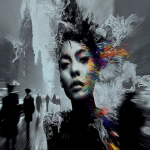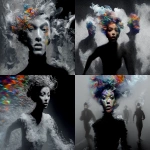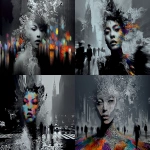Explore the Best AI Image Gallery

AI: The New Brushstroke - Reshaping Graphic Design
The world of graphic design is undergoing a profound transformation, fueled by the rapid advancements in artificial intelligence (AI). AI tools are no longer just futuristic concepts; they are actively changing how designers work, opening up new possibilities while raising important ethical questions. This blog post delves into the multifaceted impact of AI on graphic design, exploring its potential uses, the challenges it presents, and the future trends shaping this dynamic field.
The Rise of the AI Designer
AI-powered design tools are becoming increasingly sophisticated, capable of generating stunning visuals, creating unique typography, and even conceptualizing entire branding identities. These tools can automate repetitive tasks, freeing up designers to focus on more strategic and creative endeavors. Popular platforms like Adobe Sensei, Canvas Magic Write, and DALL-E 2 allow users to input text prompts and generate corresponding images, opening up a realm of possibilities for visual content creation.
Applications Across the Design Spectrum
The applications of AI in graphic design are vast and ever-expanding:
- Logo Design: AI can analyze industry trends and generate multiple logo variations based on a users brief, providing a starting point for designers to refine.
- Website Design: AI can suggest layouts, color palettes, and imagery based on target audiences and design best practices, streamlining the website development process.
- Social Media Graphics: AI can create eye-catching graphics tailored for specific platforms, automating the time-consuming task of designing content for various social media channels.
- Illustration and Artwork: AI algorithms can generate unique illustrations and artwork based on textual descriptions or style preferences, pushing the boundaries of artistic expression.
- Typography Design: AI can analyze text and suggest appropriate fonts, enhancing readability and visual appeal in design projects.
Ethical Considerations: Navigating the Uncharted Waters
While AI offers tremendous potential, it also raises several ethical concerns that need careful consideration:
- Copyright and Ownership: Questions arise regarding the ownership of AI-generated designs. Who holds the copyright—the user who provides the prompt or the AI system that created the artwork?
- Bias and Representation: AI algorithms are trained on vast datasets, which may contain inherent biases that reflect societal stereotypes. This can result in AI-generated designs perpetuating harmful representations and inequalities.
- Job Displacement: The automation capabilities of AI tools raise concerns about potential job losses for graphic designers. It is crucial to explore strategies for reskilling and upskilling designers to adapt to the evolving landscape.
- Transparency and Accountability: The decision-making processes of complex AI algorithms can be opaque, making it difficult to understand how designs are generated. Ensuring transparency and accountability in AI design systems is essential.
The Future of Design: A Collaborative Evolution
Looking ahead, the future of graphic design lies in a collaborative partnership between humans and AI. AI will continue to augment creative processes, providing designers with powerful tools to enhance their workflows and push the boundaries of innovation. However, human creativity, critical thinking, and ethical judgment will remain indispensable. Designers need to embrace lifelong learning, developing new skills to effectively collaborate with AI and shape the future of design.
Embracing the Transformation
The integration of AI into graphic design is reshaping the creative landscape, offering both exciting opportunities and challenges. By acknowledging the potential benefits while addressing ethical concerns, designers can harness the power of AI to create innovative, impactful, and inclusive designs that shape the world around us.




](https://images.ai-img.art/thumbnails/150/bd056a4718c27444e064198762f8dc8ffa1f74f1afd7dcda8d5cb8b142797d6e.webp)








](https://images.ai-img.art/thumbnails/150/0ba0be922ab76af53f75ab90126ae2b18a600ee3b96941e8ab897a9f10594e5a.webp)







](https://images.ai-img.art/thumbnails/150/a3ed6513a6661aa3ee46e0c2924d1e8888854e91d8908de39db5590dc41f8d8f.webp)


](https://images.ai-img.art/thumbnails/150/2ebdeb4f7db35100e5be5de9bc3e533a40d14e5feedefd7ffc586524a0f3ba8c.webp)

](https://images.ai-img.art/thumbnails/150/7cf5a08238f29c821f52bb4f63db48af0b7f633ff3b9f7253074d78ced9ff6f6.webp)




](https://images.ai-img.art/thumbnails/150/685ae68cfab93a7e59a71206867b060c45bd6fd3cd561c4fe60fca514b09c5f8.webp)

](https://images.ai-img.art/thumbnails/150/ff09e32d2be011c0dd785984c5c1e47839ce551a31da1bde242860b30df2aa30.webp)






](https://images.ai-img.art/thumbnails/150/847809c77ca9a73b68bc190e6efb06fec87157685a243730d5a66a403b0e6e10.webp)








